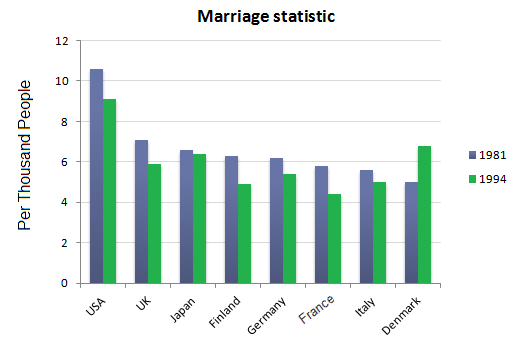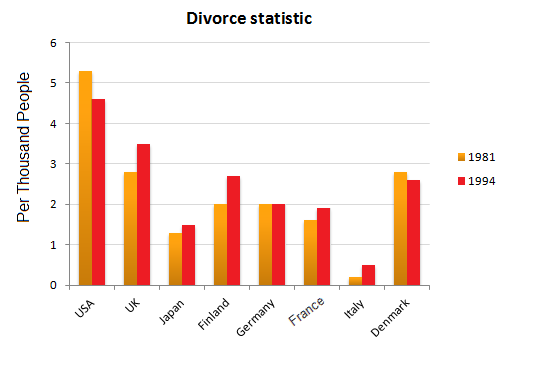IELTS writing task1 ーエッセーの構成(例)ー

IELTSで一番難関なのが、ライティングだと思います。
中には、スピーキングが苦手な方もいらっしゃると思いますが、私はライティングがとにかく難しかったです。
特に、1時間という時間制限が与えられていることで、私は焦ってしまったり、アイディアがまとまらなくて、いい文章が書けなかったりと、何度も悔しい思いをしました。
根本的に、私はこれまでエッセーを書く機会が極端に少なく、IELTSで求められるようなライティングの経験はありませんでしたので、結局これだけIELTSで大変な思いをしたのは、私の能力不足としか言いようがないと思います・・・。(涙)
さて、最近ブログの閲覧統計を見てみると、やはりIELTSに関する記事の閲覧が多く、(と言っても、まだまだ少ないのですが・・・)ブログを読まれている方もIELTSの勉強方法を模索していらっしゃるんだなと感じました。
なので、今回はTask1の構成について紹介したいと思います。
これまで私がTask1 を解く上で重要視していたポイントは次の通りです。
ぜひ参考になさってくださいね。
<ポイント>
1)基本構成は3段落〜4段落
Introduction - Body1 - Body2 - (Conclusion)という流れです。
2)Introduction では、問題文のパラフレーズをする。
(例)The bar charts below show the Marriage and Divorce Statistics for eight countries in 1981 and 1994.

*引用:IELTS MENTOR sample72
私のパラフレーズ
The bar graph shows the statistics of the marriage and divorce numbers per thousand people of eight countries in 1981 and 1994.
3)Body では「Similarlities - Differences の法則」を崩さない
今回の例はグラフが2つなのですが・・・
*グラフが1つの場合は
Body1:Similarities (共通点)
Body2:Differences(異なる点)
という順番で文章を構成すると良いでしょう。
*今回のように2つグラフがある場合は、
Body1:1つ目のグラフについてSimilarities / Differences
Body2:2つ目のグラフについてSimilarities / Differences
と、コンパクトにまとめましょう。
私の例は次の通りです。
<Body1>
According to the marriage statistics, it is clear that the US has the highest marriage rate for both given years on average of 9 whereas other nationalities showed in the range of 4 to 7. However, most countries had a higher marriage statistic in 1981 than in 1994 by nearly 1, except Denmark. Denmark was the only one country which showed an increase from 5 to 7.
<Body2>
Looking at the divorce statistics, the US was the highest in both years which exceeded 4 whereas Italy was the lowest on average of 0.5. UK and Denmark showed 2.7 on average although the UK had an increase of 0.5 within the two given years while Denmark had a slight drop of 0.2. Although the increase and decrease rates were varied, the other four countries demonstrated the rate in the range of 1.3-2.8.
4)Overall trend は必ず書く
Overall Trend は全体の特徴のことです。
これは、IntroductionかConclusionに書きます。
私は以前、IntroductionにOverall trend を書き、Conclusionは書いておりませんでしたが、ネイティブの先生からのアドバイスで、Conclusionに書くように変更しました。
*Youtubeや様々なブログでは、Task1にはConclusionはいらない!
とのアドバイスがあったりするのですが、私はConclusionを入れた方が、綺麗にまとまって、結構納得いくエッセーのスタイルになったので、途中からConclusionを入れたスタイルに変更しました。
実は、IELTSのライティングって、これが絶対!!というものはないと思います。(あくまでも個人的見解です。)
確かに、ある程度のテンプレートに従った構成であれば、Band6.0は取れるかもしれませんが、実はそれ以上を目指すには、もっと柔軟で、かつ文章の構成に一貫性のあるものが求められます。
残念ながら、私はそれが達成できなかったのですが、、、
一時期はテンプレート地獄に陥って散々な目にあったので、テンプレートはあくまでも目安とすることをお勧めします。
最後に、このエッセーの私のConclusionは次の通りです。
In conclusion, the highest marriage rate was in the US, however more people divorced simultaneously in this country. While marriage statistics for the other nations showed a similar trend, the divorce rate was vastly different in accordance with the country.
5)ワード数は180words程度を目指す
このエッセーの合計ワード数は202wordsです。
つまり、少し長すぎると思います。(こんな質のエッセーを例としてあげて、すいません・・・。)
IELTSの場合長いことに対して加点はありませんし、逆にスペルミス、文法ミスが増えてしまい、減点される可能性がありますので150 words以上と言われているので、ほどほどの長さにした方が良いでしょう。
また、150words近くを目指して書くと、単語数が足りなかった場合の心配があります。
ワード数が少ないと、Band1落ちるぐらいの大幅減点がありますので、180wordsがベターなワードカウントと言われていますよ。
それでは、IELTS学習者のみなさん、これからも勉強頑張ってくださいね!!